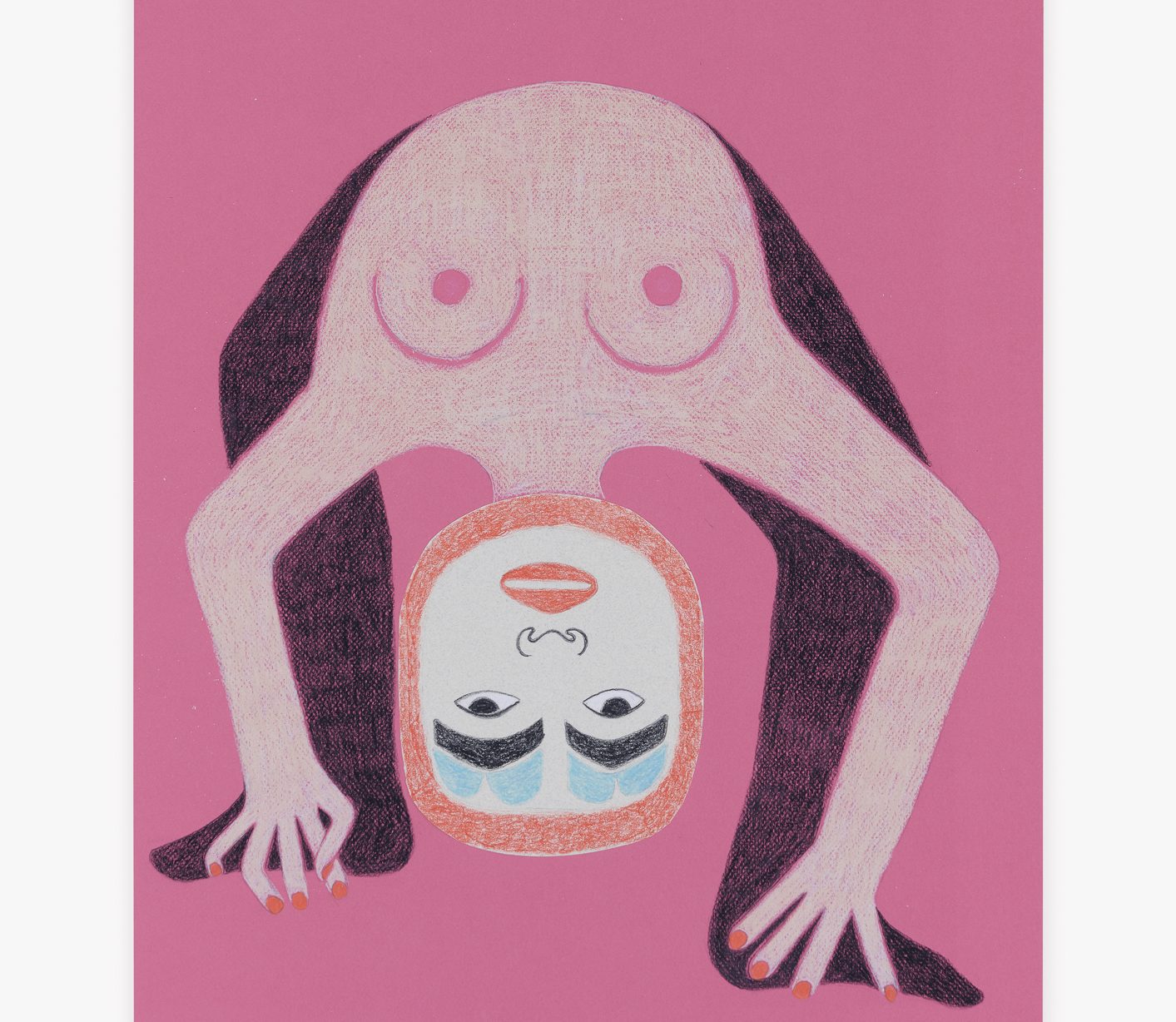“Upside down, you’re turning me / You’re giving love instinctively / ‘Round and ‘round you’re turning me” are the words I hear as I orient myself to greet the anthropomorphic beings in Rachel Martin’s head-over-heels world. A woman’s body inverted in a backbend, wearing a Tlingít mask, dexterously held up on red-painted nails––her gravityless and playful form welcomes visitors to Martin’s delightfully disorienting first solo show in New York City.
The title “Bending the Rules” befits her exhibition of drawings on paper that politically and cheekily flout convention. But the most meaningful theme in her work is love. This is what appealed to me about the Queens, New York-based artist’s work. Raised between California and the Fort Peck Indian Reservation in Poplar, Montana––also my Lakota and Dakota family’s home––Rachel Martin is an enrolled member of the Tsaagweideí, Killer Whale Clan, of the Yellow Cedar House (X̱aai Hit´) Eagle Moiety. She inherited the Pacific Northwest Coast formline technique and draws from Grace Weaver, Matisse and Picasso’s cubist and organic style, producing drawings and sculptures focused on identity, feminism and tribal sovereignty.

Descending the gallery stairs, a sense of abundance fills the medium-sized space with these larger-than-life works adorning the freshly painted walls and a last supper style work occupying its center. Turning left, turning right, flip it and reverse it, the compositions’ revolving perspective is always a return to love, reiterating in my mind Diana Ross’s classic hit; her upended romanticism is mirrored by Love is a tide is a taste is a tree, in which two figures share a cri de cœur for the decolonial return of land and love. As Mojave poet Natalie Diaz reminds us, “These are the settings that I am made from.” With masked subjects kneeling, decorated with moons, fish, rivers and trees, the piece is a monument to Native love, perhaps even a love triangle between the couple and their homelands.

Despite Martin’s abstract style, her techniques and use of color lend a dropped-in realism expressing the subjects’ standpoint, their modernity and inextricability from Tribe, femininity and place. But Martin is also puckish about how Indigenous life is co-constituted by citizenship in Native nations and the United States. Her liminal jocularity is perhaps personified best by She’s a 10 but she boils herring eggs until they’re all white and rubbery (2024). Tongue out, Converse on and strappy dress visible on an exposed shoulder, these items map to the West; whereas the mask and flowing shawl with biological formline motifs correspond to Martin’s heritage.
SEE ALSO: Observer’s Guide to This Year’s Must-Visit October Art Fairs
Her strikingly heterogeneous use of paper and color to outline and fill in her subject’s skin tone subtly points to the diversity of Native peoples who’ve lived and miscegenated with every community that arrived on Turtle Island since first contact.
Mother of Many Children is a sly tribute to this diversity. Martin deftly uses humor to humanize Indigenous people to broader audiences. While a traditional viewer may see a formline rendition of Les Demoiselles d’Avignon, queer audiences recognize this nod to New York’s 1980s and ‘90s ball culture that brought together queer Black, Latiné and Native vogue dancers. Each figure’s gesture reflecting pithy phrases from Black women and LGBTQIA2S folks gone viral on TikTok from “yas” and “it’s giving” to Wendy Williams’ “How you doin’?” and “I love you.”
The 2023 drawing, Yéil’s Sock Money displays an austere figure bearing another example of the Tlingít mask motif tucking cash into their makeshift sock-pocket in preparation for a party, indicating an equilibrium between tradition and pop culture. By extension, Rachel’s self-portrait, Hot Girl Summer (2024), is found under a canopy whose organic architecture, ornamented with a valence of drying hides and fish filets, strikes the same balance. The figures’ transition from rave to repose suggests a final summer celebration before accepting the crescent demure fall (or ‘joyfall’).

Culture Bear(er) Flex is a contemporary yet timeless example of Indigenous wisdom and figurative metamorphosis––the three sets of eyes staring with vivid, emphatic sentience, clueing the viewer into the Native ontological perspective that spirits are not defined along special or linear-time lines. In other words, the “Bear(er)”’s lucid consciousness defies the Western man/nature divide and time functioning along a straight line, but rather views it as a circle.
“Instinctively you give to me / The love that I need / I cherish the moments with you,” Ross’s words evince the presence of community and the meaning of food as medicine in If our table could talk (2024). The grounding central piece around which the rest of the show is framed is also its locus of control, naturally pulling visitors in and––after engaging these animate beings lining the walls at the gallery front––evoking agency, fate and the cycle of life. The shared meal comprising traditional Tlingít dishes of fish heads, filets and guts, lobster and sundry vegetables closes the loop, so to speak, on Martin’s metaphysical commentary and transmogrification of humans and animal spirits. Here, in Martin’s percussive honoring of her art, culture and history, she loves, she laughs and, ultimately, she eats.
“Bending the Rules” is at Hannah Traore Gallery through November 9.


